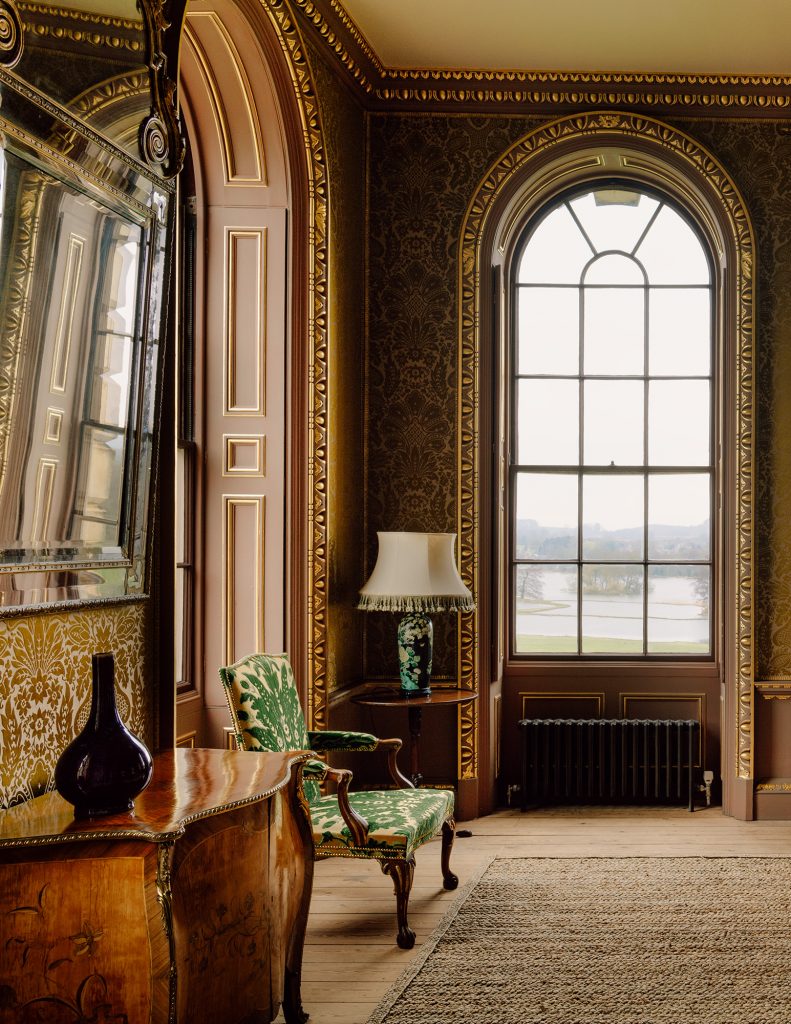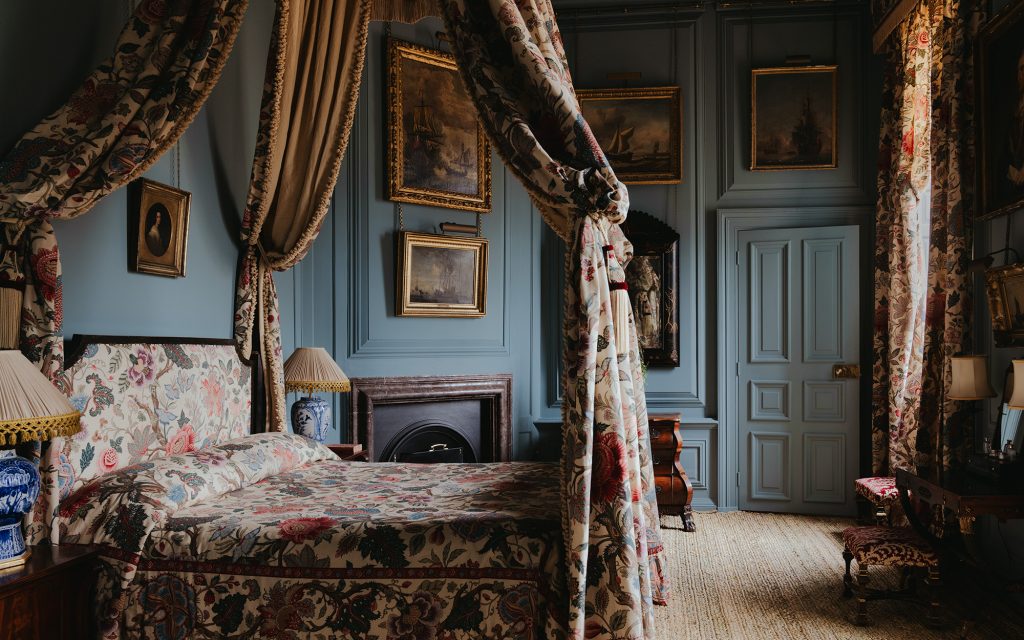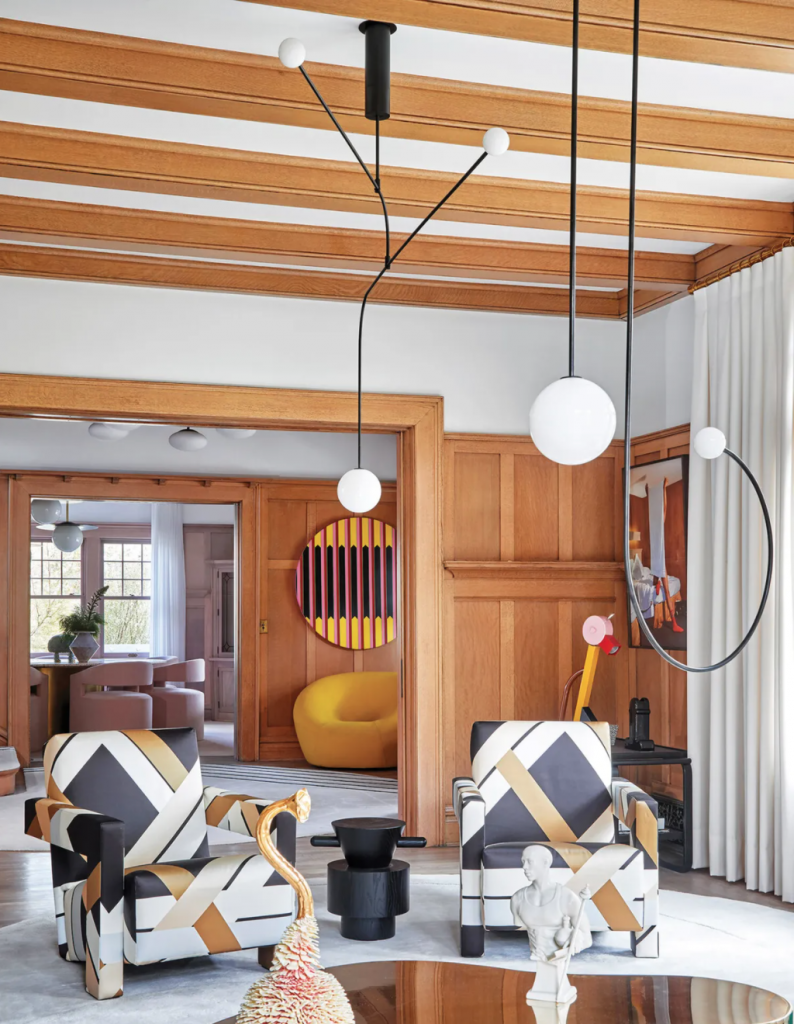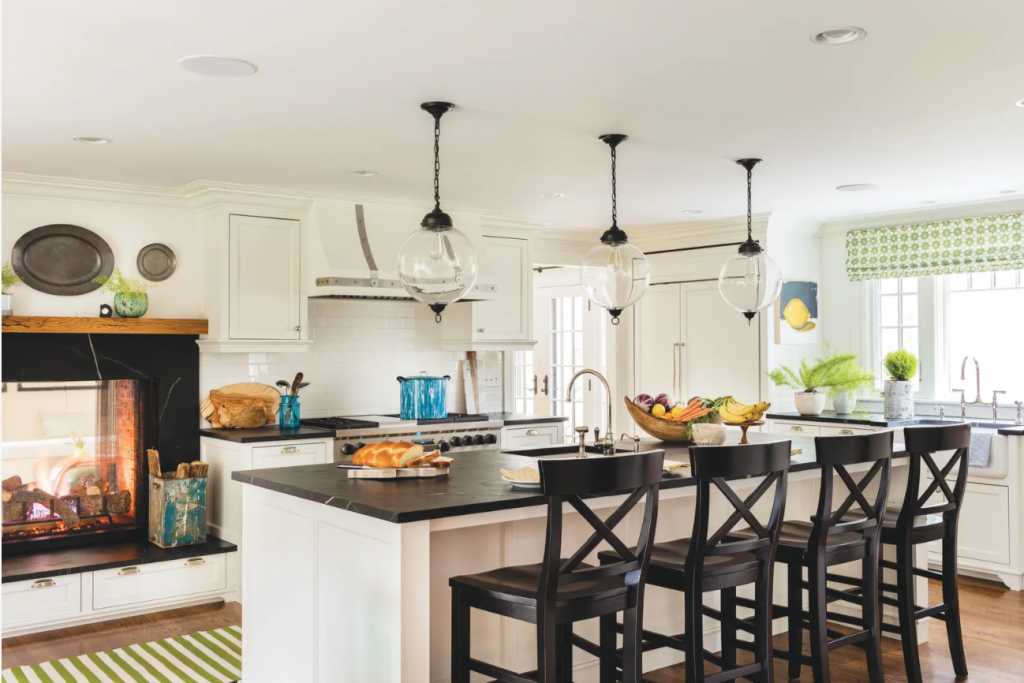Bright Young Things
A NEW GENERATION OF COLLECTORS IS REFRESHING HOW WE LIVE WITH ANTIQUES, FINDS DOMINIC BRADBURY
At a time when digital stimulation is intruding on almost every aspect of our daily lives, it’s reassuring to see a corresponding uplift in pursuits that feel less frenetic. Book sales are up across the board, slow cooking is well-established, there’s a growing revival of artisan craftsmanship and, at the same time, a resurgence of interest in collecting. All help to suggest that there are now multiple generations of well-informed, 21st-century connoisseurs interested in questions of taste, provenance, and history. A prime example is Michael Diaz-Griffith, whose book The New Antiquarians celebrates contemporary art and the culture of collecting.

“There are, demonstrably, far more young people who are collecting now than at any other time,” says Diaz-Griffith, who is based in New York and is a collector, a curator, and design consultant. “In previous periods, people were often inheriting things and buying antiques, but now they’re taking a little more time to seek out specific things. With the book, I was interested in exploring the deeper motivating forces in the lives of these people and what causes them to embark on these experiments, beginning lifelong addictions to beautiful objects. I also wanted to have a wide lens, elevating and highlighting people from very different backgrounds who have been able to build these collections around themselves.”
Diaz-Griffith’s book, published by Monacelli, visits 17 collectors from the US and the UK in their own homes, many of which are modestly scaled yet fully layered and rich in invention. The collectors demonstrate varied approaches to displaying the results of their obsessions, whether in New York, Louisiana, or London. Many of them are “insiders” of one kind or another, from the realms of art or design; all have had to navigate their way through the economic and cultural shifts of the past 20 years, explored in the book’s introduction, and have seen the antiques market rise and fall before settling into its current period of resurgence and growth.

“The main criterion was that these are people who love historic art or antiques, but also live with it in an interesting way,” says Diaz-Griffith. “The main challenge was that the younger a collector is, the smaller their home might be, so it was about finding collectors whose interiors had a finished quality that translates into a design book like this. The sense of plurality was also hugely important. I wanted for a Black American to open the book and see someone like them, to talk about the importance of aesthetics in the lives of young gay men, for example.”
The project evolved from Diaz-Griffith’s own lifelong love of collecting, and his experience curating and organizing antique events, including Manhattan’s The Winter Show for art and antiques. Even as a child, growing up in rural Alabama, he began scouting pieces from flea markets and auctions. His grandmother was an antiques dealer; his parents let him design his own bedroom and themselves became real-estate developers, although with a rather more reserved approach to their interiors.

“They were building elaborate historical reproduction houses and new urbanist developments, rather like Poundbury in England,” says Diaz-Griffith. “I was involved in their business at a young age, helping on the design with the local architect, designing metalwork, or working with the carpenters.” It was a more creative upbringing than it might seem from afar, and in such a rural area. Diaz-Griffith became “quite obsessed with early American interiors at one point and had a bedroom that was a fully conceived period room”.
His university education fused his love of literature and the decorative arts. During his first degree at the College of the Atlantic on Mount Desert Island in Maine, he met his future husband, Mexican-born painter Alonso Diaz-Rickards. The couple spent two years in the UK, before settling in New York, where Diaz-Griffith studied at the Sotheby’s Institute of Art, and joined The Winter Show, eventually becoming associate executive director. The New Antiquarians first began as an informal group of millennial collectors, co-founded with friend and colleague Benjamin Miller, which developed into a podcast and—eventually—a book.

“Benjamin and I would convene small groups of curators, art and antique dealers, and specialists from the auction houses, and have these salon-style evenings together,” says Diaz-Griffith. “One of my favorite events was a picnic in Central Park where we would all sit on antique blankets and quilts and invite people to bring their favorite object so we could have a handling session.”
The book, largely photographed by Brian W Ferry, uses the early era of World of Interiors under former editor Min Hogg as one point of inspiration. Those featured are friends, or friends of friends, and highlights include artist Andrew LaMar Hopkins and his multi-layered townhouse in New Orleans. The author first met him at The Winter Show, just as it began incorporating contemporary art in the mid-teens. “It was the opening night and Andrew was dressed in drag as his alter ego, Désirée Josephine Duplantier, which was quite a brave thing to do at the time and wonderful. He has collected a massive amount of material over the years, much of it has served as props for his own paintings.”

Argentine-British artist Pablo Bronstein’s period home in Deal, Kent, is full of color, texture, and delight while offering an exemplar of a collector with focus. There’s a particular obsession with English silver sugar casters, but also Delft pottery and 17th-century candle stands. “I knew the sugar casters needed to be in the book,” Diaz-Griffith says, “because Pablo has a wonderful way of talking about them and has this serial collection in the old-fashioned sense. But it’s also about his visual representation of his collection, which is so wonderful.” Other collectors encompass what Diaz-Griffith characterizes as a post-millennial approach to antiques within the home, where an otherwise calm and contemporary interior becomes a backdrop to a carefully conceived collection of objects. Design editor Camille Okhio and her Manhattan apartment offer one example, along with gallerist Alex Tieghi-Walker and his home in Echo Park, Los Angeles.

“It’s an emerging taste for a very cool, classic approach to collecting antiques that’s all about this minimalist background which allows objects to pop,” says Diaz-Griffith. “It’s almost like accessorizing a perfectly white button-up shirt and certainly a few interiors in the book have that feel, with the mixing of antiques and contemporary pieces in one vision.”
For the future, Diaz-Griffith is already thinking about book two, with more of a focus on established collectors and possibly a wider geographical remit. And, of course, he continues to collect. His own passions include portrait miniatures, watercolor room portraits and reverse painted glass portraits from the 19th century. Plus, American painted furniture, rattan furniture, and wicker work.
“I have set up our New York apartment rather like a conservatory to try and battle the grayness and gloom of a winter in Manhattan,” he says. “We also have Alonso’s work, and some contemporary art, and I do like things that create a dialogue among themselves. But, at this point, if I had six houses then I would just collect different things in each of them.”
Originally posted by Sotheby's International Realty.
Her Home Is A Castle
VICTORIA HOWARD IS RESTORING A STATELY HOME WITH THE HELP OF ITS DECORATIVE ARCHIVE. A FURNISHINGS LINE IS ALL PART OF THE PROCESS
One of the wonderful things about Castle Howard is its amazing archive,” says its chatelaine, Victoria Howard. “Everything has been kept, including receipts for building materials ordered by Vanbrugh and Hawksmoor,” she adds, referring to John Vanbrugh, the Restoration playwright-turned-architect, and Nicholas Hawksmoor, the protégé of Christopher Wren, who designed the house for the 3rd Earl of Carlisle, starting in 1699.

The 145-room house, which took more than 100 years to complete, is about 15 miles north-east of York and is surrounded by an 8,800-acre estate of parkland, woodland and farms. Such an old and enormous building requires constant maintenance and renovation, so there is a rolling program of works to keep the house and its rooms in good order for the 270,000 visitors it attracts every year. The extensive archives are invaluable in this respect, particularly when it comes to the decoration of the historic interiors. “Somebody had the sense to keep samples of most of the wallpapers that were put up throughout its history,” says Howard. “We have found 140 different patterns.” Luckily, these were all stored in the dark, so their original colors are fresh and vibrant. “We’ve just hung a wonderful 19th-century embossed wallpaper in one small room—there was just enough. There are fabric samples and cuttings, and some quite good lengths—some whole curtains have even been kept.”

This was too good a treasure trove to languish in a storeroom. Howard, who is an entrepreneur to the tips of her fingers, approached Watts 1874, a company that specializes in historic wallpapers and textiles, to produce the first Castle Howard collection of six fabrics and one wallpaper, which was launched in May. Of the fabrics, three are “Indiennes”—inspired by the Indian Tree of Life designs that were popular in Britain in the 18th century. One of these, Howard Indienne, and its matching border, has been used for bed hangings in the Admiral’s bedroom. There are also two ravishing floral chintzes in the collection and a pretty chinoiserie toile in deep pink. The Japanese wallpaper, Goose, a graphic pattern of stylized flying birds that can be seen on the walls of the Archbishop’s bedroom, has faded over the years. Watts will be making two new versions, one in its original colors and another with a more modern acid-yellow ground. Before taking over the running of Castle Howard in 2016 with her husband Nicholas, a photographer and a descendant of the 3rd Earl of Carlisle, Howard had a starry career in business. She co-founded the publisher 4th Estate in 1984 and rose to become the chief executive of HarperCollins, one of the world’s biggest book companies, in 2000. Their talents complement one another, she says. “Nick and I are joint chairs, it’s very much a double act. He is visual; I run the business and financial side.”

To help with the collection and with renovating some of the rooms, Howard sought out the American interior designer Remy Renzullo. He has worked closely with Watts 1874 on the fabrics and wallpaper, and also designed some beautiful bedrooms. “Vicky is amazing,” Renzullo says. “She has such a grasp of the complete concept, yet minute attention to detail. In dealing with a house this vast, most people would say: ‘Let’s just put card shades in every room’, but we’ve had different lampshades especially made for each one.” Alec Cobbe, who has advised on historic decoration and picture hanging for the Royal Collection, is part of the team working on the biggest project: the restoration of the Tapestry Drawing Room, one of 22 rooms damaged by a disastrous fire in 1940, which is still a stone shell. Cobbe has already completed the redecoration of the Lake Sitting Room, and is now engaged on a new scheme for the Long Gallery including a complete rehang.

The majority of Castle Howard’s rooms that survived the 1940 fire are now open to the public, including some dressing rooms that have been converted into bathrooms for its paying guests. Howard solved the problem of asking visitors to stand gazing at the toilet in one of them by buying a large antique wardrobe and putting the toilet inside. For those with fewer than 145 rooms to decorate, a beautiful Indienne fabric or Goose wallpaper could turn your own home into a castle.

Originally posted by Sotheby's International Realty.
Trends
JEWELERS BRANCH OUT From classic heritage labels to contemporary brands, designers turn to adorning houses as well as customers
Although different in scale, jewelry and homeware are both mainstay adornments that come to define us, and are often charged with sentimental value. As such, it is not surprising that jewelers will often try their hand at creating homeware.

Since its founding in 1847, Cartier has supplied stylish objects for the home, such as a practical inkstand and desk clock from 1908 in beautiful lilac enamel with diamond and sapphire details. To celebrate the successful moon landing mission in 1969, the firm produced a gold, lacquer and enamel replica of the “Eagle” module used by the Apollo 11 astronauts. Today, Cartier customers can find dainty musical boxes or a panther-shaped piggy bank.
The Italian fine jewelry brand Buccellati has long presented refined silverware—or, as creative director Andrea Buccellati says, “been involved in the Art de la Table world”. At Milan Design Week 2022, the brand unveiled a new collaboration with the historic Florentine porcelain manufacturer Ginori 1735, and the resulting collection “has been crucial to offer a complete range of tableware articles with a true Buccellati style,” says Buccellati. The range continues the Double Rouche decorative motif of repeated curves, which appears across the brand’s jewelry and silver table accessories.
Homeware also provides jewelers with a larger canvas for their craft. Brazilian designer Silvia Furmanovich—whose fresh aesthetic is created using the wood marquetry technique across jewelry—has extended her range to homeware.
At PAD London in fall 2022, Furmanovich presented mirrors and jewelry boxes made using her signature technique, featuring evocative nocturnal skies and natural motifs. Furmanovich’s output also extends to stools and tables.
The Greek jeweler Lito has had a successful collaboration with US-based artisanal homeware brand L’Objet. The line includes vases, trays, bookends, and more, bearing Lito’s distinct evil eye motif. Jewel-bright porcelain plates feature resin and gold detailing, and a bronze magnifying glass is inlaid with resin “lashes”.
For Paris-born, London-based jewelry designer Anissa Kermiche, homeware has become a solid second pillar for her brand after intense online interest during lockdowns in the pandemic. Her wares are all infused with her tongue-in-cheek humor, from the Breast Friend vase, which takes the form of a female bust, to the Can Candlestick (pictured left), in the shape of two dancing legs.
For Kermiche, the transition was a no-brainer: “It is jewelry for the house.”
Originally posted by Sotheby's International Realty.
Mixing Metals
COMBINING FINISHES AND SHEENS LEADS TO AN INTERESTING LOOK FOR INTERIORS
Bronze, brass, nickel, chrome—metals make for some of the most luxe and layered finishes in the home. And the beauty is, you don’t have to choose and (and stick with) just one. “Combining different metal finishes and sheens gives the impression that a design evolved over time,” says Killy Scheer of Scheer & Co., an interior design firm in Austin, Texas. “It’s a great way to create depth and a look that feels collected.”
KEEP THINGS BALANCED
While incorporating several metals into one space sets an inspired tone, most designers suggest selecting a main material that’s repeated throughout. Scheer recommends using a dominant metal and then choosing a few supporting iterations to use as accents. “If you’re working with several different components, make the dominant metal an easy one to match across different brands,” she says. “Chrome looks basically the same no matter the manufacturer, whereas oil-rubbed bronze can vary. In that case, chrome would be your dominant metal and oil-rubbed bronze can be an accent; just be sure it all comes from the same manufacturer, so the finishes always match.”
Vancouver-based designer Stephanie Brown also prefers to identify one metal as the architectural finish. “It makes for a consistent appearance throughout the home,” she says. “We’d typically use it on door hardware, railings, plumbing fixtures, lighting, and cabinet hardware. We then bring in one or two other metal finishes throughout as special accents.”
The reason it’s often best to stick with one lead metal is the look can get jumbled when warm and cold tones are all vying for the spotlight, says New York-based designer Ghislaine Viñas. It’s important to establish a hierarchy. If you’re working with brass, for example, have the doorknobs, hardware, and architectural features like faucets rendered in brass, and accessorize with other warm metals like copper or gold leaf. “This helps create a cohesive, balanced space,” Viñas says.
Another way to create balance is by playing with the way different materials and surfaces reflect light, says Cara Fox, owner and lead designer of The Fox Group in Salt Lake City. She suggests mixing a finish such as unlacquered brass—a living metal that patinas over time—with a high-lacquer paint that’s really glossy. “Similarly, a matte black or satin nickel paired with velvet or another shimmery fabric creates a beautiful contrast of sheens. Linen paired with a shiny metal will create the same effect,” Fox says.

CONSIDER THE COLOR PALETTE
Metals have either warm or cool tones, and whether you stick with all one temperature or mix things up is a matter of preference. For example, Mary Maydan, founder and principal of Maydan Architects in Palo Alto, Calif., prefers using one color family. When the color palette is white and gray, for instance, she often adds metals in cool tones such as chrome, stainless steel, or silver. “That said, it can be nice to add an accent metal, like copper, that is not in the same family to give warmth to the room. Often, we’ll do this with an accent piece, like a copper metal sculpture in a library,” she says.
The key to creating a curated look is repetition, says Nicole Michael of Nicole Michael Designs in Los Angeles. “For example, if a living room light fixture is aged brass, introduce it again through an accessory, a drinks table, a decorative mirror, or even picture frames,” she says. “When you repeat colors, it helps your eye travel through the space, creating balance in the room.”
CREATE CONTRAST
In an effort to avoid a too-industrial feel, temper the look with other textures. “Natural materials such as stone and wood always mix well with metals—but, really, the key to mixing anything successfully is creating the right contrasts,” Scheer says.
In a more eclectic or traditional interior, Brown might play off brass accents such as light fixtures with rich hues on furnishings, like jewel-toned velvets or cognac-colored leather. In a more minimal interior with black and rose gold metal, she keeps furniture and textiles soft and monochromatic in shades of gray and white with textural variation.
“One metal finish we consider a neutral is stainless steel,” Brown says. “To me, it’s the equivalent of blue jeans; it’s so common and understated that it usually doesn’t factor in as a metal and you can easily put other metals with it in the same space.” For instance, stainless kitchen appliances can be paired with one or two more metal finishes on the cabinet hardware, plumbing, and lights.

CONSIDER THE SPACE ITSELF
Just how and where you mix your metals matters. “A bathroom is a great place to mix metals,” Michael says. For example, the cabinet and door hardware can be one finish, the light fixtures a second finish, and the mirror and plumbing fixtures could be the third finish (consider looking for a two-tone piece to help tie everything together), she says. “Never mix finishes between plumbing fixtures: If the faucet is one finish and the shower head and trim are a different finish, it will read as a mistake.”
Lighting fixtures and furniture—a vintage gold lamp and a matte black metal coffee table—can provide a great opportunity for mixing metal finishes, Brown says. But this effect can also be achieved through the use of accessories—matte gold sculptural objects and picture frames on your shelves are an easy starting point, she says.
Originally posted by Sotheby's International Realty.
What’s New In Art, Architecture, And Design
THE BLENDING OF ART AND SCIENCE, MULTIPLYING PRIMARY BEDROOM SUITES, AND THE RETURN OF LAID-BACK COTTAGE-STYLE INTERIORS
Art is building on its scientific cred, residences are getting multiple primary suites, and the down-to-earth cottage look is back. Here are the latest trends in art, architecture, and design.
Art
High-tech science has become a creative force in the art world.
London-based artist Susan Aldworth explores the human identity, or as she puts it, “what makes us who we are,” in works that are in the collections of the Victoria and Albert Museum, the British Museum, and Guy’s Hospital. Her interest in the “human mind, especially consciousness and our sense of self,” has led to collaborations with scientists.
For her suite of prints Transience, she helped develop a technique to capture the authentic marks of the brain on an etching plate. And her large-scale installation Out of the Blue, comprising 106 antique garments embroidered with words spoken by epileptics and suspended from the ceiling, is moved by computer-programmed pulleys to correspond to the algorithms of electrical activity in an epileptic brain. “Science,” she says, “offers fascinating explanations and methodologies to explore the world with.”
Klari Reis, a painter based in San Francisco, experiments with new materials and methods for her scientifically themed works. Using epoxy polymer, she explores its interaction with a variety of dyes and pigments, creating compositions on aluminum and wood panels that are characterized by colorful under-the-microscope smears, bumps, and stains. Her installation Hypochondria consists of hand-painted petri dishes mounted on walls in groupings of 30, 60, or 150 pieces. Reis, whose work is on display in the Peninsula Shanghai hotel, Morgan Stanley in New York City, and the Stanford University Medical Center, collaborates with biomedical companies. She says she is “driven by curiosity and my desire to explore and document the natural and unnatural with a sense of wonder and joy.”

ARCHITECTURE
In grand estates, one of the latest luxuries gaining popularity is a series of primary bedroom suites akin to a five-star hotel. Sometimes they are two separate suites; in other instances, a pair of bedrooms shares a central bathroom.
Bobby McAlpine, the founder of the interior design and architecture firm that bears his name, says he’s designed several over the years. “When a pair of homeowners such as two couples or siblings share a vacation property, double master suites are the order of the day,” he says. “Other requests are for an upstairs master for use now and a ground-floor master for the homeowner to ‘age’ into in the future.”
The look of two primary bedrooms can create a symmetry, he says. He created mirrored primary suites in his first house, a move he described as “smart and downright pretty.”
For a client with a summer home in St. John, the U.S. Virgin Islands, Elissa Morgante, a co-principal of Morgante Wilson Architects in Evanston, Ill., designed a pair of main bedroom suites—one on the first floor and one on the second, creating chic symmetry.

DESIGN
Cottage style—that humble-chic aesthetic—is making a comeback, particularly in accessory buildings such as carriage houses and pool houses.
“The human scale of the cottage is a perfect mix of softened roof lines and quaint, well-scaled facades,” says architect Kevin ten Brinke, a principal of KT2 Design Group in Sudbury, Mass. With interiors characterized by painted or decorated furniture, weathered finishes, floral fabrics, a garden-in-bloom color palette, vintage features, and natural textural accents like baskets, cottage style is “a great way of exploring more fun expressive details that would otherwise be too informal for the main residence,” he notes.


Originally posted by Sotheby's International Realty.





